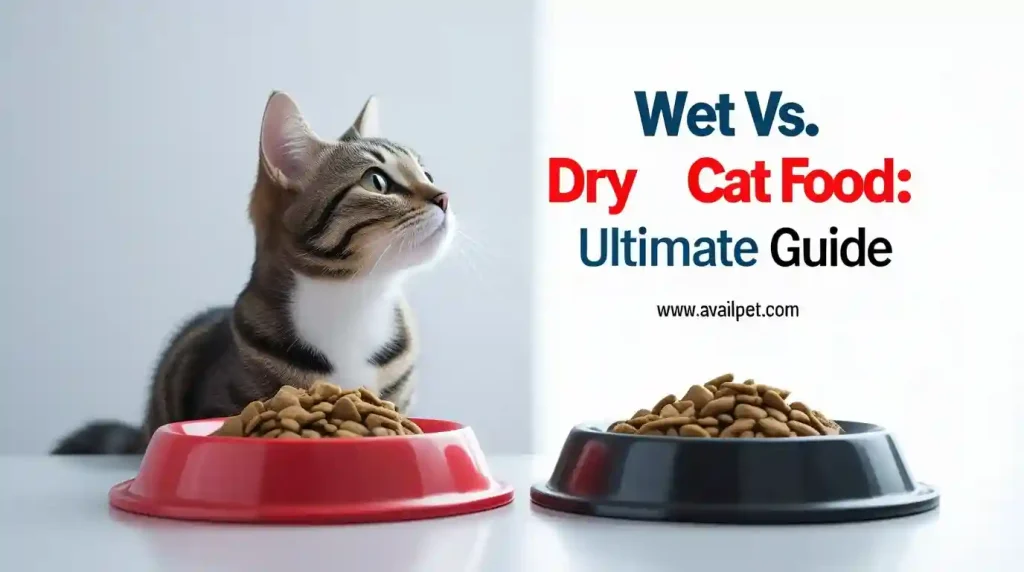Key Takeaways: Best Cat Food for Sensitive Stomach
- Choose Limited Ingredients: The best cat food for sensitive stomach features novel proteins (duck, rabbit) and easily digestible carbs to minimize triggers.
- Prioritize Gut Health: Look for natural prebiotics and probiotics in cat food for sensitive stomach to support healthy digestion and nutrient absorption.
- Transition Slowly: Switch to new sensitive stomach cat food gradually over 7-14 days to prevent further digestive upset.
- Consult Your Veterinarian: Rule out serious conditions before choosing any best cat food for sensitive stomach, as vomiting/diarrhea can signal underlying health issues.
Disclaimer: Always consult your veterinarian for persistent digestive problems. This information is vet-reviewed but not a substitute for professional medical advice.
Watching your cat struggle with frequent vomiting, diarrhea, or digestive discomfort is worrying and frustrating. When your feline friend can’t keep their food down or experiences ongoing stomach issues, you know something needs to change. Finding the best cat food for sensitive stomach isn’t just about stopping the symptoms—it’s about restoring your cat’s comfort and well-being.
Digestive problems can stem from food allergies, intolerances to certain ingredients, or underlying health conditions. The right nutrition can make all the difference, transforming mealtime from a source of stress to a solution for better health. But with countless options claiming to help sensitive stomachs, how can you identify what truly works?
This guide cuts through the confusion. We’ve analyzed veterinary science and real-world results to bring you our top picks for the best cat food for sensitive stomach in 2025. We’ll help you understand the key ingredients to look for, what to avoid, and how to transition your cat safely to their new diet.
Understanding Feline Digestive Sensitivity
A sensitive stomach in cats can manifest in various ways, from occasional vomiting to chronic digestive upset. Understanding the root causes is the first step toward finding the right nutritional solution.
Food Allergies vs. Food Intolerances
It’s crucial to distinguish between these two common triggers:
- Food Allergies: Involve an immune system response to specific protein sources (most commonly beef, dairy, or fish). Symptoms often include both digestive issues and skin problems like itching or redness.
- Food Intolerances: Don’t involve the immune system but rather difficulty digesting certain ingredients, which can include proteins, carbohydrates, or additives.
Common Symptoms Checklist
Watch for these signs of digestive sensitivity:
- Frequent vomiting (especially shortly after eating)
- Diarrhea or soft stools
- Gas or bloating
- Occasional constipation
- Lethargy after meals
- Weight loss despite normal appetite
When to See a Vet Immediately
While many sensitive stomach issues can be managed with diet, certain symptoms require immediate veterinary attention:
- Blood in vomit or stool
- Repeated vomiting over 24 hours
- Severe lethargy or signs of pain
- Dehydration symptoms (dry gums, loss of skin elasticity)
- No improvement after dietary changes
Understanding these distinctions will help you better communicate with your veterinarian and choose the most appropriate cat food for sensitive stomach for your feline companion.
Key Ingredients to Look For (and Avoid)
Choosing the right ingredients is crucial when selecting food for a cat with a sensitive stomach. Here’s what to prioritize and what to steer clear of:
Ingredients to Look For:
Novel Protein Sources: Look for limited ingredient diets featuring proteins your cat hasn’t been exposed to, such as:
- Duck
- Rabbit
- Venison
- Lamb
Prebiotics and Probiotics: These are essential for restoring and maintaining a healthy gut flora.
- Prebiotics (like FOS – Fructooligosaccharides) act as food for beneficial gut bacteria.
- Probiotics are live, beneficial bacteria that aid digestion.
Easily Digestible Carbohydrates: Some cats benefit from a source of highly digestible energy.
- Sweet Potato
- Pumpkin (can also help with firming stools)
- Peas
Hydration Support:
- Wet food formulas are often easier to digest due to their high moisture content. For a complete analysis of the benefits and trade-offs, see our ultimate guide on Wet vs. Dry Cat Food.
Ingredients to Avoid:
Common Allergens: These proteins are frequent culprits in food sensitivities.
- Beef
- Dairy
- Fish (for some cats)
- Chicken (surprisingly common)
Artificial Additives:
- Artificial colors, flavors, and preservatives (like BHA, BHT, ethoxyquin) can irritate the digestive system.
Hard-to-Digest Fillers:
- Corn, Wheat, and Soy are common fillers that offer little nutritional value and can be difficult for some cats to process.
- By-products and meat meals of unspecified origin can be inconsistent and contain irritants.
By focusing on a simple, high-quality ingredient list, you can significantly reduce the triggers for your cat’s sensitive stomach.
Our Top Picks: Best Cat Food for Sensitive Stomach 2025
Finding the right food for your cat’s digestive issues can be transformative. After evaluating dozens of formulas for their ingredients, efficacy, and palatability, our veterinary experts have selected these top-performing sensitive stomach cat foods for 2025.
Important Note: Always transition to new food gradually over 7-14 days. Consult your veterinarian if symptoms persist, as they may indicate an underlying health condition requiring medical treatment.
1. Best Overall: Hill’s Science Diet Sensitive Stomach & Skin
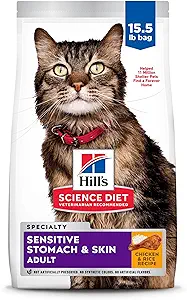
- Form: Dry & Wet
- Primary Protein: Chicken
- Key Benefit: Prebiotic fiber for digestive health and vitamin E for skin
- ✅ Check Price: View on Amazon
Best For: Cats with mild to moderate sensitivity who need a balanced, vet-recommended diet that supports both digestive and skin health.
2. Best Limited Ingredient: Blue Buffalo Basics Limited Ingredient Diet
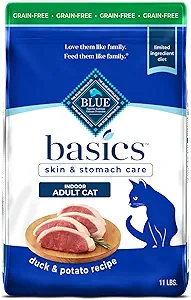
- Form: Dry & Wet
- Primary Protein: Duck, Salmon, or Turkey
- Key Benefit: Single animal protein source with easily digestible carbohydrates
- ✅ Check Price: View on Amazon
Best For: Identifying food allergies or intolerances through elimination, featuring novel proteins and limited ingredients.
3. Best for Food Allergies: Royal Canin Selected Protein
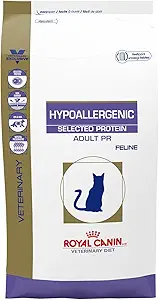
- Form: Dry & Wet
- Type: Prescription Required
- Primary Protein: Duck, Rabbit, or Venison
- Key Benefit: Highly hydrolyzed protein for cats with severe allergies
- ✅ Check Price: View on Amazon
Best For: Cats with diagnosed food allergies requiring a veterinary-prescribed diet with novel or hydrolyzed proteins.
4. Best with Probiotics: Purina Pro Plan Sensitive Skin & Stomach
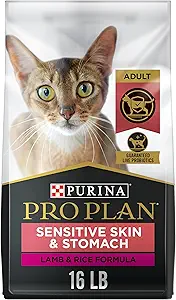
- Form: Dry & Wet
- Primary Protein: Salmon or Lamb
- Key Benefit: Live probiotics for digestive and immune health
- ✅ Check Price: View on Amazon
Best For: Ongoing digestive support, combining prebiotic fiber and natural probiotics to maintain gut health.
5. Best Hydrolyzed Protein: Hill’s Prescription Diet z/d
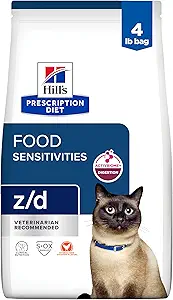
- Form: Dry & Wet
- Type: Prescription Required
- Primary Protein: Hydrolyzed Chicken
- Key Benefit: Clinically proven nutrition for food sensitivities
- ✅ Check Price: View on Amazon
Best For: Severe food allergies where proteins are broken down into tiny components to avoid immune system recognition.
Comparison Table for Best Cat Food for Sensitive Stomach
| Product | Type | Primary Protein | Key Benefit | Best For |
| Hill’s Science Diet Sensitive Stomach | Non-Prescription | Chicken | Prebiotic fiber & vitamin E | Overall digestive and skin health |
| Blue Buffalo Basics L.I.D. | Non-Prescription | Duck/Salmon/Turkey | Single protein & limited ingredients | Identifying food triggers via elimination diet |
| Royal Canin Selected Protein | Prescription | Duck/Rabbit/Venison | Novel protein sources | Diagnosed food allergies requiring novel proteins |
| Purina Pro Plan Sensitive | Non-Prescription | Salmon/Lamb | Live probiotics | Ongoing gut health maintenance |
| Hill’s Prescription Diet z/d | Prescription | Hydrolyzed Chicken | Hypoallergenic formula | Severe food allergies needing hydrolyzed proteins |
Important: Prescription diets like Royal Canin Selected Protein and Hill’s z/d require veterinary authorization and are specifically formulated for diagnosed medical conditions.
How We Selected These Foods
At AvailPet, we understand that trusting your cat’s digestive health to a new food is a significant decision. Our selection process is designed to be thorough and transparent, ensuring every recommendation meets the highest standards for safety, efficacy, and scientific backing.
Our veterinary and research team applied these key criteria:
- Scientific Formulation & Ingredient Quality:
We prioritized foods with high-quality, easily digestible ingredients. This includes novel or hydrolyzed protein sources, prebiotics, probiotics, and the absence of common irritants like artificial additives and hard-to-digest fillers. - Brand Reputation & Safety Record:
We favored established brands with a long history of quality control, scientific research, and transparency. A thorough review of FDA recall history and manufacturing standards was a mandatory part of our evaluation. - Veterinary Endorsement & Clinical Evidence:
We gave significant weight to diets, both prescription and non-prescription, that are widely recommended and used within the veterinary community for managing food sensitivities and digestive issues. - Palatability & Real-World Effectiveness:
The best food is useless if your cat won’t eat it. We analyzed consistent feedback from thousands of user reviews and veterinary reports to ensure our picks are not only gentle but also readily accepted by cats. - Specificity for Sensitive Stomachs:
Each selected product is explicitly formulated to address digestive sensitivity, whether through limited ingredients, novel proteins, or the inclusion of gut-supporting supplements.
By applying this consistent, multi-faceted framework, we provide you with sensitive stomach cat food recommendations you can trust to help soothe your feline friend’s digestive issues.
Implementing an Elimination Diet
An elimination diet is the gold standard for identifying specific food allergies or intolerances in cats. This methodical process helps pinpoint exact ingredients that trigger your cat’s sensitive stomach.
Step-by-Step 8-12 Week Process
Weeks 1-2: Transition Period
- Gradually introduce the novel protein diet while phasing out current food
- Monitor closely for any changes in digestion, skin, or energy levels
- Keep a detailed symptom journal tracking:
- Frequency of vomiting/diarrhea
- Stool consistency
- Skin condition
- Energy levels and behavior
Weeks 3-8: Strict Novel Protein Diet
- Feed exclusively the elimination diet
- No treats, table scraps, or flavored medications
- If symptoms resolve, proceed to challenge phase
- If no improvement, consult your veterinarian
Weeks 9-12: Challenge Phase
- Introduce one original ingredient at a time
- Wait 2-3 days between new ingredients
- Watch for return of symptoms
- Document any reactions clearly
How to Identify Trigger Ingredients
Common culprits to test include:
- Chicken
- Beef
- Fish
- Dairy
- Wheat
- Corn
- Soy
Working with Your Veterinarian
- Get professional guidance before starting
- Regular check-ins during the process
- Blood tests may be recommended to rule out other conditions
- Prescription diets may be necessary for accurate testing
Important: Never attempt an elimination diet without veterinary supervision, as nutritional imbalances can occur if not properly managed.
Transitioning to New Food & Ongoing Management
Successfully switching your cat to a new sensitive stomach food requires patience and careful monitoring. Here’s how to ensure a smooth transition and long-term digestive health.
Gradual Transition Schedule (7-14 Days)
Follow this timeline to minimize digestive upset:
- Days 1-3: 25% new food mixed with 75% current food.
- Days 4-6: 50% new food mixed with 50% current food.
- Days 7-9: 75% new food mixed with 25% current food.
- Days 10-14: 100% new sensitive stomach food.
For cats with severe sensitivity: Extend each phase by 2-3 days for a 3-week transition.
Monitoring Progress & Symptoms
Track these indicators in a daily journal:
- Stool Quality: Note consistency, frequency, and color
- Vomiting Episodes: Record timing relative to meals and appearance
- Appetite & Energy Levels: Monitor interest in food and activity patterns
- Coat & Skin Condition: Watch for improvements in fur quality and reduced itching
When to Try a Different Formula
Consider switching to another sensitive stomach formula if:
- No improvement after 4-6 weeks on the new diet
- Symptoms worsen during or after the transition period
- Your cat refuses to eat the new food after several attempts
- New symptoms develop that weren’t present before
Pro Tip: Keep a dedicated “transition notebook” to track exactly what you’re feeding and how your cat responds. This data will be invaluable for your veterinarian if further dietary changes are needed.
FAQs About Best Cat Food for Sensitive Stomach
How long does it take for sensitive stomach food to work?
Most cats show improvement within 2-4 weeks of starting a sensitive stomach diet. However, it can take up to 8-12 weeks to see full results, especially if you’re addressing chronic issues or food allergies. Consistency is key—stick with the new diet without mixing in other foods or treats for accurate results.
Can I mix sensitive stomach food with regular food?
During the initial transition period (7-14 days), yes—this helps your cat adjust. However, after the transition, we don’t recommend mixing sensitive stomach food with regular food. Mixing can introduce potential trigger ingredients and make it difficult to determine what’s working. For long-term management, feed the sensitive stomach formula exclusively.
Are grain-free diets better for sensitive stomachs?
Not necessarily. While some cats with grain sensitivities do better on grain-free diets, true grain allergies are rare in cats. Most digestive issues are caused by protein sources (like chicken, beef, or fish) rather than grains. Focus on the protein source first, and consider grain-free only if protein changes don’t help.
What’s the difference between sensitive stomach and hairball formulas?
- Sensitive stomach formulas focus on easy digestion with limited ingredients, novel proteins, and prebiotics/probiotics.
- Hairball formulas typically contain increased fiber to help move hair through the digestive tract.
Some cats may need both, but start with a sensitive stomach formula first if digestive upset is the primary concern.
Conclusion & Final Recommendation
Helping your cat overcome digestive sensitivity requires patience and the right nutritional approach. Finding the best cat food for sensitive stomach can transform your cat’s quality of life, turning mealtime from a source of stress into a solution for better health.
Our top pick, Hill’s Science Diet Sensitive Stomach & Skin, stands out for its balanced approach that supports both digestive and skin health without requiring a prescription. However, the ultimate choice depends on your cat’s specific needs—whether they require the novel proteins in Blue Buffalo Basics L.I.D., the probiotic support of Purina Pro Plan Sensitive, or the veterinary-formulated solutions for severe cases.
Remember these key principles for managing your cat’s sensitive stomach:
- Transition Gradually: Always switch foods slowly over 7-14 days
- Keep a Food Journal: Track what works and what doesn’t
- Be Patient: It can take 4-8 weeks to see full results
- Partner with Your Vet: Professional guidance is essential for persistent issues
By combining these strategies with the right food and veterinary support, you’re giving your cat the best chance for comfortable digestion and lasting well-being.
Sources
- Cornell Feline Health Center – Feline Inflammatory Bowel Disease
- WSAVA Global Nutrition Guidelines
- Journal of Veterinary Internal Medicine – Food Responsive Enteropathy
- Hill’s Science Diet Sensitive Stomach & Skin
- Blue Buffalo Basics Limited Ingredient Diet
- Royal Canin Selected Protein
- Purina Pro Plan Sensitive Skin & Stomach
Disclaimer: Always consult your veterinarian if your cat shows persistent digestive issues, as vomiting and diarrhea can indicate serious medical conditions. These product suggestions are not a substitute for professional diagnosis. We may earn from qualifying purchases.




